The Earth's Biosphere is a result of several
factors:
Seasonal Changes
Tides
Atmosphere
Carbon Cycle
Weather
Global Warming |A
Photo Gallery
Seasons:
It can be argued that a delicate balance is
present here on Earth providing the environment for
life to flourish. When we compare the extreme
environment on
Venus - with its well over 200 degree
days and nights - and the lack of seasonal changes
on
Mars as a result of a thinning atmosphere and
cold
temperatures, it is easy to see the importance
of our own biosphere. Of all the factors involved
with the preservation of life, nothing is more
evident than the seasonal changes on Earth.

The seasons are a result of the Earth's tilt.
Contrary to popular belief, the Earth is not a
greater distance from the
Sun during winter -
actually the Earth is closer to the
Sun during
winter! The reason for colder days is the shorter
length of the day. During the summer months, the
days are long and the
Sun heats up the Earth's
surface more so than in winter. The
Sun is also
higher in the sky during the summer months - a low
Sun during winter spreads out the heat of the
Sun over the Earth's surface.
The Seasons (Northern Hemisphere):
- Spring - March 21
- Summer - June 21
- Autumn - September 22
- Winter - December 21
The Seasons (Southern Hemisphere):
- Autumn - March 21
- Winter - June 21
- Spring - September 22
- Summer - December 21
For those who do not live in a "four seasons"
environment, Spring is typical of wind and rain,
Summer brings hot weather and some rain
(thunderstorms as well), Autumn indicates
cooling and some rain, and Winter having the
shortest days, cold weather, rain and snow.
Rain (the release of condensation within
clouds) can be a year around event, with heavier
rains in more tropical environments (because of
rapid
temperature changes and moist air due to
oceanic breezes). Rain - also known as
precipitation - during the winter can freeze so
the resulting weather brings snow. During rapid
temperature changes of summer, such higher
elevation freezing can result in hail, or frozen
rain.
Back to Top
Tides:

The
tidal motions of our oceans are a result of the
Moon's gravity influence. The result of the ocean's
motions provide
energy for two very important
effects:
 |
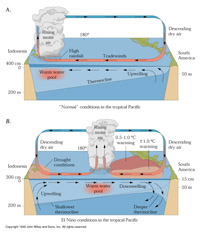 |
| Movement of the hot and
cold ocean currents a result of a moving
ocean. |
El Nino is the effect of
shifting
temperature changes in the tropical
regions of the ocean. |
For those of us in California, the tide is an
important event to predict as this can invariably
affect the surf. The NOAA offers a
Water Level Tidal Predictions website for more
information. Your local weather station may also
have tide charts - but only if you live near the
coast.
Back to Top Atmosphere:
Our atmosphere is very unique. While our primitive
atmosphere was probably closer to the methane
variety like Titan's atmosphere in the past,
greenhouses gases, liquid water and the presence of
plant life have shaped our atmosphere to its
breathable, life-sustaining present. The purpose of our
atmosphere is twofold: filter out harmful solar
radiation and various regions of the
EM-Band, and
keep in some Solar radiation to maintain the surface
temperature.
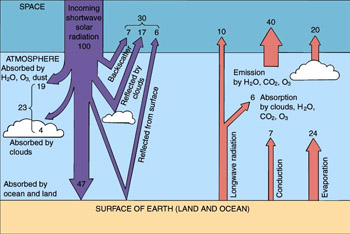
The solar radiation also has a curious effect -
clouds. Clouds are the close formation of water
vapor. Rising and falling of air produces
condensation resulting in cloud formations.
In addition to cloud formation,
temperature
variations also produce winds. The warm equatorial
regions and a spinning Earth produce clearly defined
bands of circulation.
Our atmosphere as a whole boasts eight layers
(from sea level on up):
- Troposphere
- Tropopause
- Stratosphere
- Stratopause
- Mesosphere
- Mesopause
- Thermosphere
- Ionosphere (not really a layer, but
important)
 |
Instead of sharply delineated borders
between our atmosphere and space, the
thermosphere gradually diminishes until
there are not enough particles in a cubic
space to constitute a layer. Because of the
gradual dispersion of particles, the
temperature in this region can climb pretty
high. The Tropopause can shift position due
to seasonal changes, and marks the location
of the Jet Streams - rivers of high winds
energized by UV radiation. The Ozone Layer
exists just above the Tropopause. |
The Mesosphere marks the location of
decreased Oxygen. Very high mountains can pierce the
Mesosphere and hypoxia (lack of oxygen in humans)
occurs. The Ionosphere is not really a layer, but a
region of charged particles as a result of Solar
Radiation. Radio waves bounce off this region. For a
more detailed look at our atmosphere:

Back to Top
The Carbon Cycle:
The process of a "breathable" atmosphere is a
direct result of what is called the Carbon Cycle.
Water exists as a liquid here on Earth because of
the
temperature - and the
temperature is a result of
greenhouse gases trapping Solar Radiation so the
Earth is warm. The process of introducing greenhouse
gases (gases that trap infrared Solar energy) like
carbon come from Plate Tectonics, or the movement of
the continental plates. This movement results in
several unpleasant reactions - like earthquakes and
volcanoes - but are required for carbon
introduction. The image below best describes how
this process works:
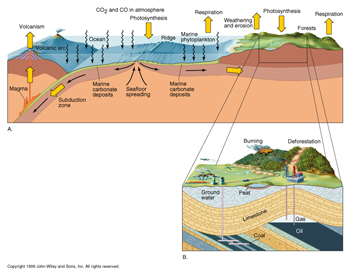
Back to Top
Weather (finally):
Weather is the phenomenon related to the effects of
condensation, wind, and Solar Radiation.
Temperature
changes and seasonal variations provide the
environments for weather to occur. Overall, weather
is somewhat predictable in that certain weather
patterns occur only during specific seasons - like
thunderstorms and tornadoes during the Summer in
West and Northern Texas. There is quite a laundry
list of phenomenon that is considered weather (from
the
National Weather Service):
Winter Storms
High Winds
Freezing Rain
High Surf
Fog
Freezing Fog
Floods
Thunderstorms
Snow
Rain (Precipitation)
Tornados
Hail
Hurricanes
Tropical Storms
Tsunamis
The
National Weather Service has a website that
provides up to date weather information and
real-time maps and radar. As far as local weather,
its difficult to find a forecast website that is not
loaded with adds and pop-up windows. The National
Weather Service does has some
local stations so its possible your region will
be near one of these locations - and its pop-up
free.
Back to Top
Global
Warming:
We are not caring for our planet.
The balance of natures own introduction of
greenhouse gases is being countered by our own
introduction of greenhouse emissions from cars,
factories, and chemicals.
We are doing three terrible things
to our planet:
-
Adding to the level of
greenhouse gases
-
Deforestation cannot process
natures introduction of carbon much less the
additional carbon released by humans
-
Using chemicals like CFC's to
punch a hole in our Ozone
Plants cleans the carbon out of the
air and produces oxygen. Less plant life means less
of this photosynthesis - or producing oxygen from
carbon through the Sun's energy. The Ozone layer
protects us from the higher energy UV radiation
(ultraviolet radiation). In addition to increased
risk of skin cancer, UV exposure also increases risk
of cataracts and Macular Degeneration (something I
know about working with eyes). So what of the Ozone
hole?
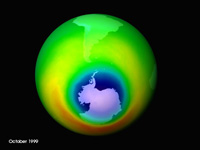 |
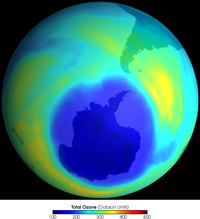 |
| The Ozone Hole Over
Antarctica - 1999 |
The Ozone Hole Over
Antarctica - 2001 |
Also, notice the levels of Ozone in the
surrounding regions using the color bar - compare
1999 to 2001 and you can see there is a great danger
here.
To keep up with the progress of the Ozone Hole -
visit
NASA's Ozone Hole Watch.
Also, think of how a melting Antarctica can
dramatically change the ocean
temperature - using
the ocean current image presented earlier, just
imagine how that can change the global climate.
Back to Top
The Earth's weather related photo gallery:
 |
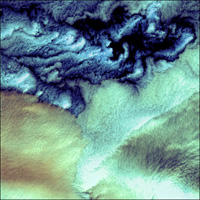 |
| Contrails from Jet
Aircraft |
Aleutian Clouds |
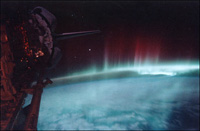 |
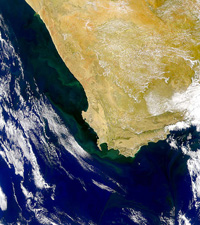 |
| Aurora Australialis from
the Space Shuttle |
Ocean Chlorophyll |
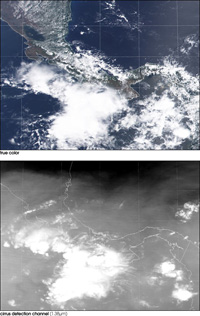 |
 |
| Cirrus Clouds - Best
Views in Infrared |
The Coral Atolls |
 |
 |
| Full Globe with Hurricane
Andrew |
Antarctica - The Ross Ice
Shelf |
 |
 |
| Hurricane Andrew |
Lightning from Space |
 |
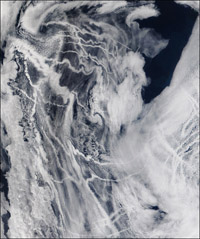 |
| Phytoplankton Blooms |
Shipping Tracks |
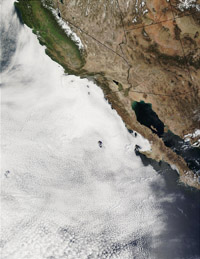 |
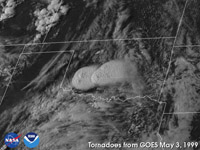 |
| Statocumulus Clouds |
Tornados from Space |
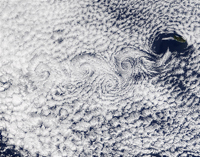 |
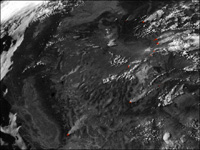 |
| Vortex - Wind Circulation
Example |
Wildfires from Space |
Back to Top |

